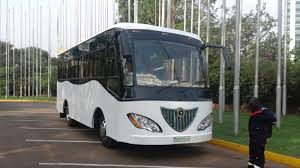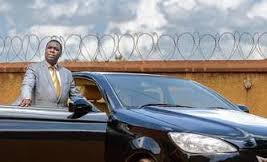Betting on a Green future, Uganda embarks on the long road to motor vehicle manufacturing
 KAMPALA,MAY 12 -There is nothing to draw attention to the big residential house standing in an expansive compound in the Ntinda suburb of Kampala, except for the white mid-size bus sporting solar panels on the roof. Until mid February, passersby barely paid any attention to the small round Kiira Motors logo hanging above one of the entrances. These days however, the gate man has to bear the frequent comings and goings with fortitude as he must open and close the heavy metal gates every so often.
KAMPALA,MAY 12 -There is nothing to draw attention to the big residential house standing in an expansive compound in the Ntinda suburb of Kampala, except for the white mid-size bus sporting solar panels on the roof. Until mid February, passersby barely paid any attention to the small round Kiira Motors logo hanging above one of the entrances. These days however, the gate man has to bear the frequent comings and goings with fortitude as he must open and close the heavy metal gates every so often.
Sitting on a dull black steel plate with concentric rings of the bright yellow and signature red of the Uganda flag circling a Crested Crane, Uganda’s national bird, this signpost is as much an embodiment of the character and ambition of the group of people working behind these high walls. Simple yet determined.
“We built it from here,” Ms Pauline Korukundo, the Vehicle Integration Manager at Kiira Motors says explaining the source of the scars and dents in the floor of the garage where one of Kiira Motor Corporation’s earlier creations, the Kiira Smack EV hybrid sedan, unveiled to the public in 2014 is parked.
 Pauline is one of a small group of driven young, gender neutral people, driving Uganda’s quest for a sit on the automotive manufacturing high table. She has been involved in the thick of developing two of Kiira Motors concept vehicles from the drawing board and actually donning a workman’s coveralls to bring the concept to life.
Pauline is one of a small group of driven young, gender neutral people, driving Uganda’s quest for a sit on the automotive manufacturing high table. She has been involved in the thick of developing two of Kiira Motors concept vehicles from the drawing board and actually donning a workman’s coveralls to bring the concept to life.
Powered by a dual electric and Internal Combustion Engine drive, the Smack is the second concept vehicle KMC has built, after the all electric Kiira EV that was put on the road in 2011. More recently on February 16, Ugandan President Yoweri Museveni launched the Kayoola Solar Bus, a 35 seat bus that relies entirely on an electric drive. Solar panels mounted on the roof extend its 80 kilometre nominal range by an additional 12 kilometres.
Sitting in his office on the third level of this temporary headquarters, Kiira Motors Chief Executive Officer, Paul Isaac Musasizi, is not yet done but he is happy to be where he is. KMC was recently invited to be the Green Mobility Partner at the Sustainable Innovation Expo that will run alongside the United Nations Environmental Assembly, due in Nairobi later this month.
Specifically, the appearance in Nairobi means putting the Kayoola Solar Bus on display at the expo that is expected to attract more than 1200 international delegates.
In her March 16 invite to KMC, Lindsay Baxter, the Commercial Director at Climate Action who are organizing the expo says, “Given Kiira Motors efforts in driving the development of Africa’s first solar powered bus, it is a pleasure to showcase your technology to highlight the high levels of sustainable innovation taking place in Uganda.”
Musasizi sees this as not only an opportunity to meet and greet potential partners but to showcase the capacity for technology innovation that is resident in Africa.
“We should be able to have some informal discussions with the different aspirations represented at the assembly and cultivate opportunities’ for partnerships in the different aspects underlying technology innovation he says.
“But the choice of the Kayoola bus goes a long away to demonstrate that the world is endorsing and recognising that Africa, Uganda and Kiira motors in particular, are now seated on the high table of sustainable innovation for mobility,” he adds.
KMC plans to start commercial production of motor vehicles in Uganda in 2018 with an initial 300 unit run although annual production would have reached 60,000 units a year by 2025. The government has allocated 100 acres of land for the KMC car manufacturing plant in Jinja 80 kilometres east of Uganda’s capital, Kampala. Cadastral and topographical surveys; environmental impact assessment; and geotechnical analysis of the site have been completed.
The company plans to produce sedans, SUV’s, light and commercial trucks as well as buses.
The proposal to manufacture vehicles in Uganda has generated a lot of domestic debate with some questioning why it should be a priority. Musasizi sees benefits for the wider economy.
 “Manufacturing motor vehicles in Uganda will create a platform for high-tech employment in the country,” he argues.
“Manufacturing motor vehicles in Uganda will create a platform for high-tech employment in the country,” he argues.
But the benefits go beyond that. Across all big cities, air quality is becoming a big issue and motorized transport is one of the contributors.
According to recent studies by Kiira Motors, the estimated 9000 strong fleet of 14-seater commuter buses that ply the Ugandan capital daily, emit 96,715 tons of carbon annually. Musasizi is convinced that the environmental dividend from replacing not just Kampala’s but Africa’s urban commuter fleet with the Kayoola Solar Bus, should on its own be compelling enough to support commercialization of its production.
“The Kayoola represents a step-change that has the potential to move Africa away from the pollution and safety risks associated with the dominant mode of public conveyance in its cities today,” he says.
KMC has crafted a 25 year plan over the course of which it will progressively domesticate Kiira’s engineering and production. The plan begins with what can viably be done in Uganda, progressively scaling up to 2035 when he hopes that ninety percent of the vehicle’s manufacturing will be done in Uganda. Economics allowing, even major parts such as the power plant could be made in Uganda.
It is projected that the Ugandan automotive industry will create 12,000 direct jobs during the capital expenditure phase and another 2,000 during the operational stage.
To de-risk the programme, KMC plans to partner with an already established original equipment manufacturer. This will not only bring experience on board but resolve questions of economies of scale.
Writing in the African Policy Review journal last month, Alec Erwin notes that while not all vehicles and their components in the African market would be sourced from African production locations; it is possible for Africa to become balance of payments neutral and add a large sector to its economy that is very productive and creates high quality employment.
“Success will depend on intelligently designed partnerships between and among governments, national investors and the global OEM – both assembly and componentry. However, the process has to be pragmatic and accept that it is the competitive economics of this vast, technologically advanced industry and its leading OEM that shape the reality for sustained and intelligent state interventions through industrial policy partnerships,” he argues.
Musasizi says though the efforts of Kiira Motors may be humble, they aim to demonstrate that “the development of complex engineering systems that advance possibilities to meet Africa’s primary needs would need sustainable development goals and ensure that our capacity to meet the needs of today does not compromise the capacity of tomorrows generation to meet their needs.”
Uganda is joining the fray of motor vehicle manufacturing almost 130 years to the day the automobile was invented. The industry has undergone a lot of changes since then and its future a subject of debate in a world increasingly sensitive to rising temperatures.
Musasizi is unfazed. For one, he believes driving will remain an aspiration for a majority of people during the coming 100 years and the internal combustion engine is not quite dead. That is where he sees Uganda and Africa’s opportunity.
Besides, ongoing discussions around the automotive industry’s contribution to the global warming present more of an opportunity than an obstacle for new entrants to the industry. According to the Global Fuel Efficiency Initiative report on fuel economy 2014, the global transport sector contributes a quarter of global green house gas emissions. But the sector is rising so fast that the number of vehicles is expected to increase three fold by 2050.
This has made the reduction of carbon dioxide emissions through a more fuel efficient automotive industry a global agenda with a target to achieve a 50 percent improvement in fuel economy for light duty vehicles as early as 2030.
By playing in the sustainable technology game newcomers such as KMC can come up with mobility solutions that will propel them directly to the pedestal of technological innovation as demonstrated by products such as the Kayoola Solar Bus. Launched just this year, it has elicited interest from around the globe with several offers of partnerships.
Musasizi believes that such aspirations are not farfetched. “If this innovation is facilitated with the right mix of policy, patronage, funding and partnerships for capacity development, the opportunities that lie ahead in creating an indigenous technology drawing from the natural resources of Africa, especially solar energy can become a reality,” he says.

 African Heads of state head to South Korea next week for Summit talks
African Heads of state head to South Korea next week for Summit talks
 Trading leads as main source of income for Ugandans
Trading leads as main source of income for Ugandans
 New leadership for bankers’ umbrella as total assets top $12 billion
New leadership for bankers’ umbrella as total assets top $12 billion
 Brussels Airlines to announce Nairobi service
Brussels Airlines to announce Nairobi service
 SITA promises enhanced travel experience after Materna acquisition
SITA promises enhanced travel experience after Materna acquisition
 Saudia’s 105 aircraft order stretches A320neo lead over rival Max
Saudia’s 105 aircraft order stretches A320neo lead over rival Max
